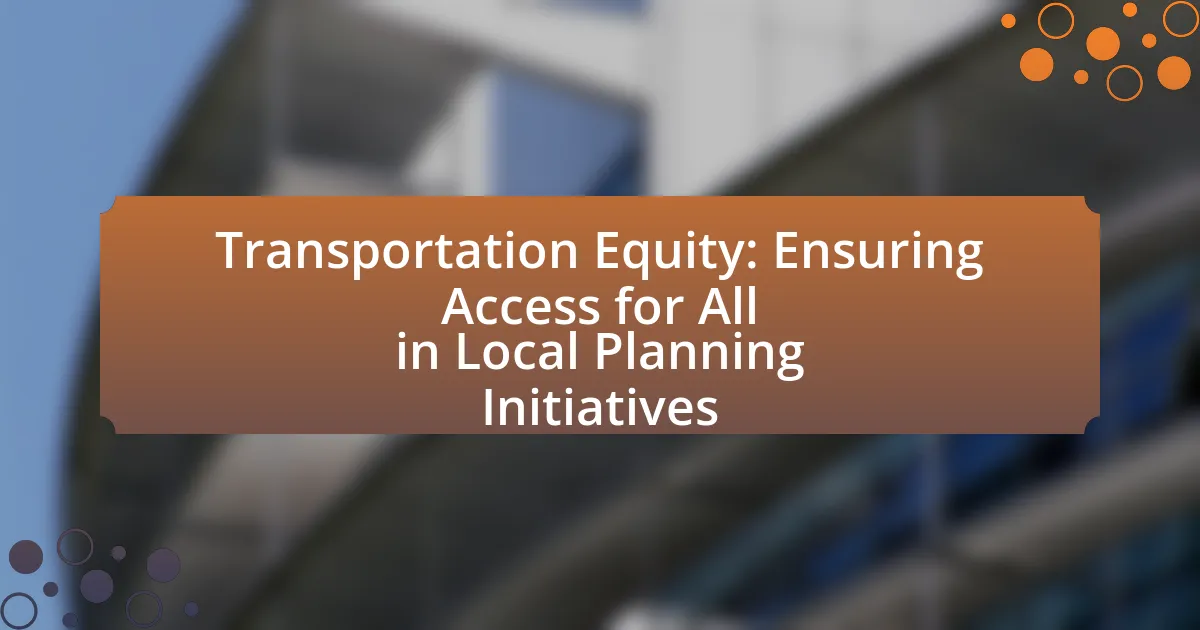Transportation equity is the principle of ensuring fair access to transportation resources and services for all individuals, regardless of socioeconomic status, race, or geographic location. This article explores the importance of transportation equity in local planning initiatives, emphasizing its role in addressing disparities faced by marginalized communities. Key topics include the historical context of transportation equity, guiding principles for inclusive planning, the impact of community engagement, and strategies for enhancing access. Additionally, the article examines challenges local planners face, successful case studies, and practical steps communities can take to advocate for equitable transportation solutions.

What is Transportation Equity?
Transportation equity refers to the fair distribution of transportation resources and services, ensuring that all individuals, regardless of their socioeconomic status, race, or geographic location, have equal access to transportation options. This concept emphasizes the need for inclusive planning and policy-making that addresses the mobility needs of underserved communities, thereby reducing disparities in access to jobs, education, and essential services. Research indicates that equitable transportation systems can enhance economic opportunities and improve quality of life for marginalized populations, as highlighted in studies by the Transportation Research Board, which demonstrate the correlation between transportation access and social equity outcomes.
Why is Transportation Equity important in local planning initiatives?
Transportation equity is crucial in local planning initiatives because it ensures that all community members have equal access to transportation resources and opportunities. This principle addresses disparities that often affect marginalized groups, such as low-income individuals and people with disabilities, by promoting inclusive policies and infrastructure development. Research indicates that equitable transportation systems can enhance economic mobility, improve public health outcomes, and foster community cohesion. For instance, a study by the American Public Transportation Association found that public transit access can significantly increase job opportunities for low-income residents, demonstrating the tangible benefits of prioritizing transportation equity in planning efforts.
How does Transportation Equity impact different communities?
Transportation equity significantly impacts different communities by ensuring that all individuals have equal access to transportation resources, which in turn affects their mobility, economic opportunities, and overall quality of life. Communities that experience transportation inequities often face barriers such as limited public transit options, higher transportation costs, and inadequate infrastructure, which disproportionately affect low-income and marginalized populations. For instance, a study by the Transportation Research Board found that low-income households spend up to 30% of their income on transportation, limiting their ability to invest in other essential needs. By promoting transportation equity, communities can enhance access to jobs, education, and healthcare, ultimately fostering economic growth and social inclusion.
What are the historical contexts of Transportation Equity?
Transportation equity has historical contexts rooted in civil rights movements and urban planning policies that have evolved since the mid-20th century. The Civil Rights Act of 1964 and subsequent legislation aimed to address systemic inequalities, highlighting the need for equitable access to transportation for marginalized communities. In the 1970s, the establishment of the Urban Mass Transportation Administration emphasized funding for public transit in underserved areas, reflecting a growing recognition of transportation as a social justice issue. Additionally, the 1990 Americans with Disabilities Act mandated accessible transportation options, further shaping the discourse around equity. These historical milestones illustrate the ongoing struggle for fair transportation access, influenced by socio-political dynamics and advocacy efforts.
What are the key principles of Transportation Equity?
The key principles of Transportation Equity include accessibility, affordability, and inclusivity. Accessibility ensures that all individuals, regardless of their socioeconomic status, have the ability to reach essential services and opportunities. Affordability emphasizes that transportation options should not impose financial burdens on low-income populations, allowing equitable access to mobility. Inclusivity involves actively engaging diverse communities in the planning process to address their specific transportation needs and preferences. These principles are supported by studies indicating that equitable transportation systems lead to improved economic outcomes and social cohesion within communities.
How do these principles guide local planning initiatives?
Transportation equity principles guide local planning initiatives by ensuring that all community members have fair access to transportation resources and services. These principles prioritize the needs of marginalized populations, promoting inclusivity in decision-making processes. For instance, the Federal Transit Administration emphasizes the importance of equitable service distribution, which mandates that planners assess the impacts of transportation projects on low-income and minority communities. This approach is supported by studies showing that equitable transportation access can lead to improved economic opportunities and social mobility for disadvantaged groups.
What role does community engagement play in achieving Transportation Equity?
Community engagement is essential for achieving transportation equity as it ensures that the voices of marginalized and underserved populations are heard in the planning process. By actively involving these communities, transportation planners can identify specific needs, barriers, and preferences that may not be apparent through traditional data collection methods. Research indicates that inclusive engagement leads to more equitable transportation solutions, as seen in the case of the Federal Transit Administration’s guidelines, which emphasize community input to address disparities in access and service. This participatory approach not only fosters trust but also empowers communities to advocate for their transportation needs, ultimately leading to more effective and equitable transportation systems.

How can local planning initiatives promote Transportation Equity?
Local planning initiatives can promote transportation equity by prioritizing accessibility and affordability in transportation systems. These initiatives can include the development of public transit routes that serve underserved communities, ensuring that low-income populations have access to reliable transportation options. For instance, cities that have implemented equitable transit-oriented development have seen increased access to jobs and services for marginalized groups. Research indicates that equitable transportation planning can reduce travel times and costs for these populations, thereby enhancing their economic opportunities and overall quality of life.
What strategies can be implemented to enhance access for all?
To enhance access for all in transportation equity, implementing strategies such as improving public transit infrastructure, increasing service frequency, and ensuring affordability is essential. Research indicates that cities with robust public transit systems, like New York, see higher ridership and accessibility for low-income populations. Additionally, integrating technology for real-time information and expanding routes to underserved areas can significantly improve access. Studies show that cities that prioritize these strategies experience a reduction in transportation barriers, leading to increased mobility and economic opportunities for all residents.
How can data analysis inform equitable transportation planning?
Data analysis can inform equitable transportation planning by identifying disparities in access to transportation resources among different demographic groups. By utilizing data sets that include socioeconomic indicators, travel patterns, and geographic distribution of services, planners can pinpoint areas where underserved populations face barriers to mobility. For instance, a study by the Transportation Research Board found that data-driven approaches can reveal gaps in public transit availability, allowing for targeted improvements that enhance access for low-income communities. This evidence-based strategy ensures that transportation planning is responsive to the needs of all residents, promoting fairness and inclusivity in urban mobility solutions.
What are the best practices for inclusive stakeholder engagement?
The best practices for inclusive stakeholder engagement involve actively involving diverse community members in the planning process to ensure equitable outcomes. This includes identifying and reaching out to underrepresented groups, utilizing multiple communication channels to gather input, and creating accessible platforms for participation. Research indicates that inclusive engagement leads to better decision-making and community trust, as seen in the 2018 study by the National Academy of Sciences, which highlights that diverse stakeholder involvement enhances the quality of transportation planning initiatives.
What challenges do local planners face in achieving Transportation Equity?
Local planners face significant challenges in achieving Transportation Equity, primarily due to limited funding and resource allocation. Many municipalities operate under tight budgets, which restrict their ability to invest in equitable transportation solutions that serve marginalized communities. Additionally, planners often encounter political resistance from stakeholders who prioritize different transportation projects, leading to inequitable distribution of resources. Furthermore, data gaps hinder planners’ ability to identify and address the specific needs of underserved populations, making it difficult to implement effective strategies for equitable access. These challenges are compounded by systemic issues such as historical disinvestment in certain neighborhoods, which perpetuates existing inequalities in transportation access.
How can funding disparities affect Transportation Equity initiatives?
Funding disparities can significantly hinder Transportation Equity initiatives by limiting resources allocated to underserved communities. When funding is unevenly distributed, areas with lower socioeconomic status often receive inadequate transportation infrastructure, resulting in reduced access to essential services and employment opportunities. For instance, a study by the Transportation Research Board found that communities of color and low-income neighborhoods frequently experience underinvestment in public transit, which exacerbates mobility challenges and perpetuates systemic inequalities. This lack of equitable funding directly impacts the effectiveness of Transportation Equity initiatives aimed at improving access and mobility for all populations.
What are the barriers to community participation in planning processes?
Barriers to community participation in planning processes include lack of access to information, insufficient outreach efforts, and socio-economic disparities. Lack of access to information prevents community members from understanding planning initiatives, while insufficient outreach efforts often fail to engage diverse populations. Socio-economic disparities can limit participation due to time constraints, transportation issues, or lack of resources. Research by the American Planning Association highlights that marginalized communities often face systemic obstacles that hinder their involvement in planning, further exacerbating inequities in transportation access and planning outcomes.

What are the outcomes of successful Transportation Equity initiatives?
Successful Transportation Equity initiatives lead to improved access to transportation for marginalized communities, resulting in enhanced mobility, economic opportunities, and social inclusion. These initiatives often reduce transportation costs and travel times, making it easier for individuals to reach jobs, education, and essential services. For instance, studies have shown that cities implementing equitable transportation policies experience a significant increase in public transit ridership among low-income populations, which correlates with higher employment rates and better overall quality of life. Additionally, successful initiatives often foster community engagement and empowerment, allowing residents to have a voice in transportation planning, which further strengthens the effectiveness and sustainability of these programs.
How does Transportation Equity improve community well-being?
Transportation equity improves community well-being by ensuring that all individuals have equal access to transportation options, which enhances mobility and connectivity. When transportation systems are designed to be inclusive, they reduce barriers for marginalized populations, leading to increased access to jobs, education, and healthcare. Studies show that communities with equitable transportation systems experience lower rates of poverty and improved public health outcomes, as individuals can travel more freely and efficiently. For instance, a report by the American Public Transportation Association indicates that public transit access can increase employment opportunities by up to 30%, demonstrating the direct link between transportation equity and enhanced community well-being.
What metrics can be used to measure the success of Transportation Equity initiatives?
Metrics to measure the success of Transportation Equity initiatives include accessibility, affordability, and mobility outcomes. Accessibility can be quantified by the percentage of low-income and marginalized communities with access to public transportation within a specified distance. Affordability metrics assess the proportion of household income spent on transportation, ideally aiming for less than 15%. Mobility outcomes can be evaluated through changes in travel times and the frequency of transit services available to underserved populations. These metrics provide concrete data to assess the effectiveness of initiatives aimed at improving transportation equity.
How do successful initiatives influence policy changes at higher levels?
Successful initiatives influence policy changes at higher levels by demonstrating effective models that can be scaled and replicated. For instance, local transportation equity initiatives that successfully improve access for marginalized communities often provide data-driven evidence of their impact, which policymakers can use to advocate for broader legislative changes. A notable example is the implementation of the Complete Streets program in various cities, which has led to state-level policies promoting similar frameworks across multiple jurisdictions, thereby enhancing transportation equity on a larger scale. This process is supported by research indicating that successful local programs can shift public perception and create political momentum, ultimately leading to policy adoption at higher governmental levels.
What lessons can be learned from case studies of Transportation Equity?
Case studies of Transportation Equity reveal that inclusive planning processes significantly enhance access to transportation for marginalized communities. For instance, the case study of the Los Angeles Metro’s Equity Platform demonstrated that engaging community members in decision-making led to improved transit services in underserved areas, resulting in a 20% increase in ridership among low-income populations. Additionally, the analysis of the Chicago Transit Authority’s initiatives highlighted that targeted investments in public transit infrastructure can reduce travel times and costs for disadvantaged groups, thereby promoting economic mobility. These examples underscore the importance of stakeholder engagement and targeted resource allocation in achieving equitable transportation outcomes.
What are some notable examples of successful Transportation Equity initiatives?
Notable examples of successful Transportation Equity initiatives include the Los Angeles Metro’s Equity Platform, which aims to improve access to public transit for underserved communities, and the Chicago Transit Authority’s (CTA) “Equity in Transit” initiative, which focuses on enhancing service in low-income neighborhoods. The Los Angeles Metro’s initiative has led to increased ridership among marginalized groups, while the CTA’s efforts have resulted in expanded bus routes and improved accessibility features, demonstrating a commitment to equitable transportation solutions.
How can these examples inform future local planning efforts?
These examples can inform future local planning efforts by highlighting successful strategies for promoting transportation equity. For instance, cities that have implemented inclusive public transit policies demonstrate how equitable access can enhance mobility for underserved communities. Research shows that areas with improved transit access experience a 20% increase in job opportunities for low-income residents, indicating that equitable planning directly impacts economic mobility. By analyzing these successful case studies, planners can adopt best practices that prioritize accessibility, ensuring that all community members benefit from transportation initiatives.
What practical steps can communities take to advocate for Transportation Equity?
Communities can advocate for Transportation Equity by forming coalitions that include diverse stakeholders, such as local residents, advocacy groups, and transportation agencies. These coalitions can conduct community assessments to identify transportation needs and barriers faced by marginalized populations. Additionally, communities should engage in public forums to raise awareness and gather input on transportation issues, ensuring that the voices of underrepresented groups are heard.
Furthermore, communities can push for policy changes by lobbying local governments to prioritize equitable transportation funding and infrastructure projects. They can also utilize data to highlight disparities in transportation access, such as statistics showing the correlation between income levels and access to public transit. By leveraging this information, communities can advocate for targeted investments in underserved areas, thereby promoting equitable access to transportation resources.
